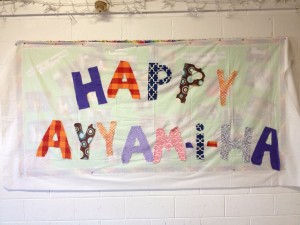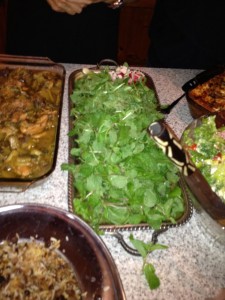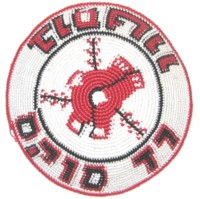As I write the Five Days of Ayyam-i-ha are winding down…Amy is rustling around downstairs getting ready for E’s birthday party on Saturday (24 3 and 4 year olds–brace for impact!), heedless of the fact that she must rise before sunup to eat and say prayers before the Bahá’í 19-day fast (Ramadan-style) begins. So let’s quickly explore this holiday that is both like and not like Fat Tuesday, sounds a whole lot like a Jewish ritual skullcap, and provides yet another opportunity to explore Persian rice-based cuisine.
The Bahá’í calendar has 19 months of 19 days each=361 days, four (or five) shy of a year. As befits a faith that views science and learning as vitally important, this shortfall is remedied by a five-day period whose name means “days out of time.” Bahá’ís see this as a time for doing gifts of charity and community service, welcoming family and friends, and, at least in North America, exchange gifts. For our girls, the modest gift giving at this time completes the extremely robust three-legged stool of gifting that they enjoy right through the winter (closing out the Hanukkah and Christmas cycle). In a way the experience of American Bahá’ís with Ayyam-i-ha strikes me (a friend, not an adherent) as kind of similar to American Jews and Hanukkah. Placed within the gigantic gravitational field of Christmas, we people of minority faiths seem to find a way to take whatever holiday happens to fall more or less within the gifting zone and make it work.
So how is Ayyam-i-ha like Fat Tuesday? Last day (or five!) before a period of fasting and reflection…dedicated in part to celebration…and everyone competes to see who can get the most bead necklaces. Actually there is nothing in the sacred texts that defines what to do all that precisely, which sort of fits with my friendly outsider’s impression of the faith as taking much more of an open-source approach than the big three. Bahá’ís do not have clergy, so it’s up to the members of the local community to organize themselves and worship according to their own sense of adherence to the faith’s precepts. OK, those precepts include no drinking, so we can remove one Fat Tuesday parallel and generally deflate our dream of eating at a Bahá’í-themed chain restaurant in a big box mall near you.
The local community in our town has many Bahá’ís who were born in Iran and emigrated to the US. Through them I have learned yet another horrifying aspect of the Iranian regime that most Americans probably don’t know, which is that Bahá’ís are deprived of all civil rights in Iran, cannot attend university, and have faced violence and death since the revolution. Having these Persian folks around provides a welcome opportunity to get to know this ancient and deliciousdistinguished culture without the terrible baggage of the current regime. It’s a comfortable situation as a Jew because all gatherings revolve around enormous, highly specialized and taste-specific meals. This particular dinner started with sabzi, which just means greens, to accompany one of the many awesome rice dishes that are the Persian specialty. Our elegant hosts (both doctahs, naturally) explain that the main dish tonight is adas polo: polo is the term for rice cooked with something in it, and adas are lentils. There is another kind of rice dish that involves saffron, and carefully burning the bottom part of the rice in just the right way, and flipping the whole thing so that the rice and whatever has been cooked with the rice stays together beautifully. I keep hearing it is a 2500 year old culture so give me a few more years to get all these down. Please pass the rice.
Years ago, Amy and I realized that Ayyam-i-ha sounds a heck of a lot like “Yarmulke” (pronounced “yah-mi-kuh” by us Amurricans). We thought, what more beautiful and instructional way to further connect our two faiths for the sake of the girls (sniff!) than to write a charming, best-selling children’s book that explores these punny relations. Like our other book projects and just about all our projects that involve creative time and reflection, this has not yet come to fruition, but with apologies to Richard Wilbur and his wonderful books of Opposites (poems for kids of all ages), here is my effort to bring these homonyms even closer:
Ayyam-i-ha tops off the year
With extra days and pre-Lent cheer.
A yarmulke also sits on top,
A reverent grace note on your kopf.
Whether in Hebrew or in Farsi,
The Good Book says to raise the bar, see
How both years and heads can fit
A built-in extra little bit.





